A company, to reach its equilibrium and to find price and output determination under perfect competition (figure 6.6).
Conditions of Price and Output Determination Under Perfect Competition
1.) A marginal income must be at least equal to the marginal cost, that is, MR=MC. If MR is higher than MC, there is always a reason for the company to increase production even more and profit after selling extra costs instead of reducing output, as the additional unit is more to the cost than revenue. Profits are maximum only at the point where MR=MC.
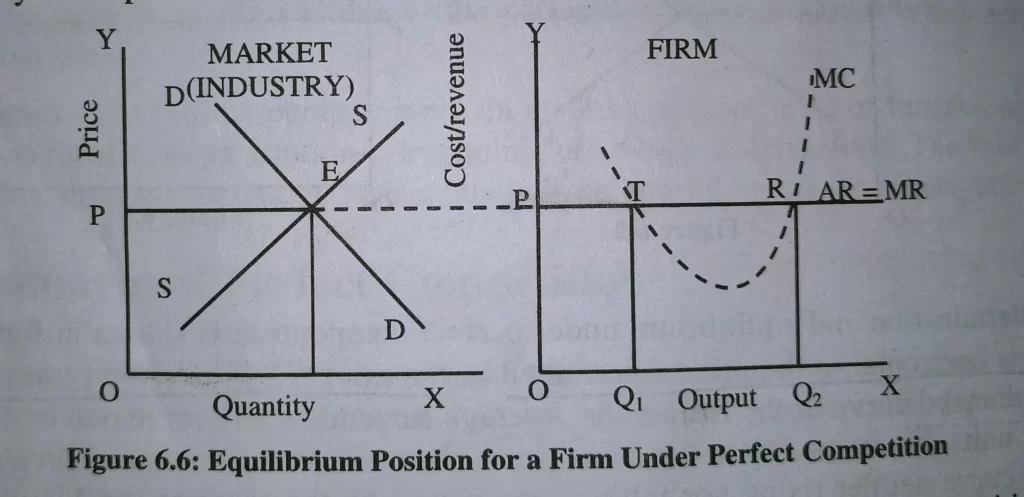
2.) The MC Curve should cut the MR curve below.
Price Determination and Equilibrium of the Firm in the Short Run
A company is a cost taker instead of an individual price maker in the marketplace. The difference in the role of industry competitive to the role of a company in determining price and output determination under perfect competition is apparent in the below diagram:
1) Abnormal Profit/Supernormal Profit

A business may make unusual profits at the equilibrium level of output when its average earnings exceed the cost of production by an average. In diagram 6.7, the firm’s equilibrium is at point E when the MC curve meets with the MR curve. When the firm is at OP prices, the company generates OQ output. The company’s average income (AR) equals EQ when it produces OQ output. Its average cost (AC) will be BQ because AR is higher than AC. Firms get abnormal profits. In the end, companies experience abnormal profits (EB) in unit output. It is the total profits (PABE), the per-unit profit divides by total output.
2) Losses
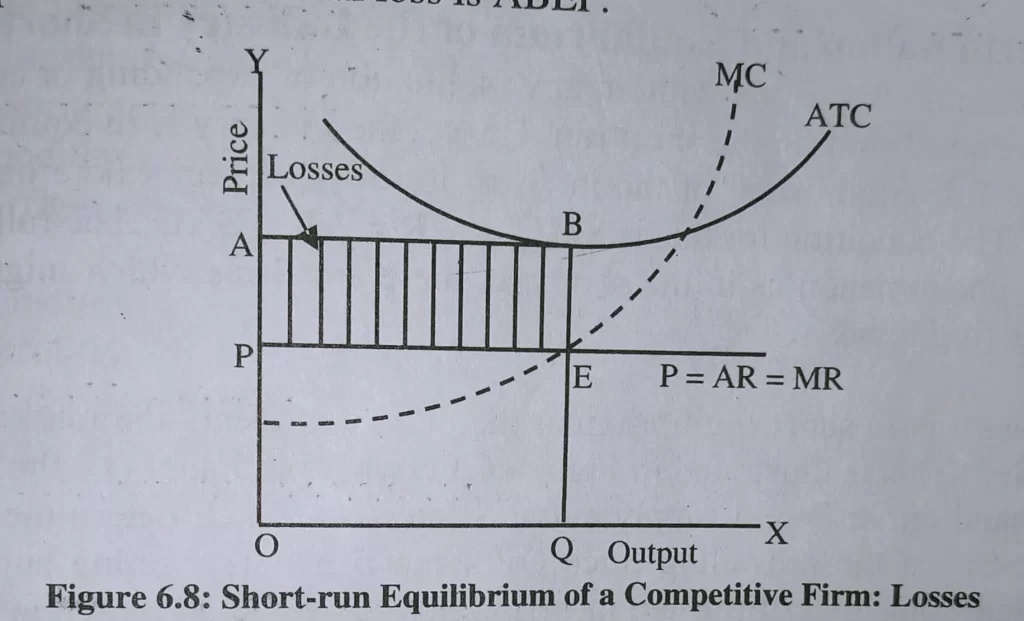
In the event of an equilibrium output, firms can suffer losses. A seller might not recoup a portion of fixed costs in the short term. Despite these losses, the company may choose to produce to cover its average variable costs. In figure 6.8. The equilibrium value and, at this point, AR=EQ while AC=BQ as BQ is greater than EQ. The firm earns BE per loss unit, and the total loss is the amount of ABEP.
3) Normal profits or Break-Even
If the company only covers its total costs, it makes normal profits.
Here AR = ATC
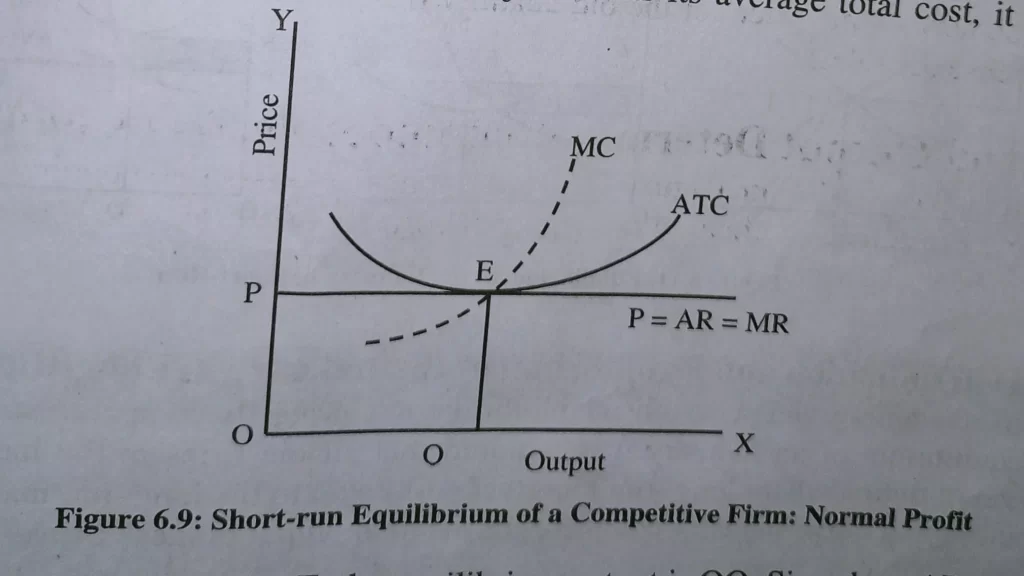
Figure 6.9 illustrates how MR=MC at E. The final output of the equilibrium is called OQ. Since AR=ATC or OP=EQ, the company gets normal profits.
Conclusion of Price and Output Determination Under Perfect Competition:
I) If AR is equal to AC, the company will earn normal profits (i.e., break-even)
II) IfAR > AC, the firm will receive normal profits.
II) If AR is less than AC the company will incur a loss.
IV) If AR is less than AVC the company will cease production.
Price and Output Determination Under Perfect Competition and Equilibrium in the Long Run
The ability to enter or leave firms is not a problem in a highly competitive market. The firms that are inefficient are then able to lose money and close the business or improve their effectiveness. New companies attract profit-driven firms to establish because of the entrance of new producers, the quantity of the commodity rises, and the cost of the commodity falls.
All firms are at break-even because of the loss of profits. It results from the long-term equilibrium between the industry and firm in a perfect market. Also, price and output determination under perfect competition, whereas all firms break even and make regular profits in the long term. Firms operate in a zero-loss-no-profit scenario where AR=AC is graphically plots in Figure 6.10.
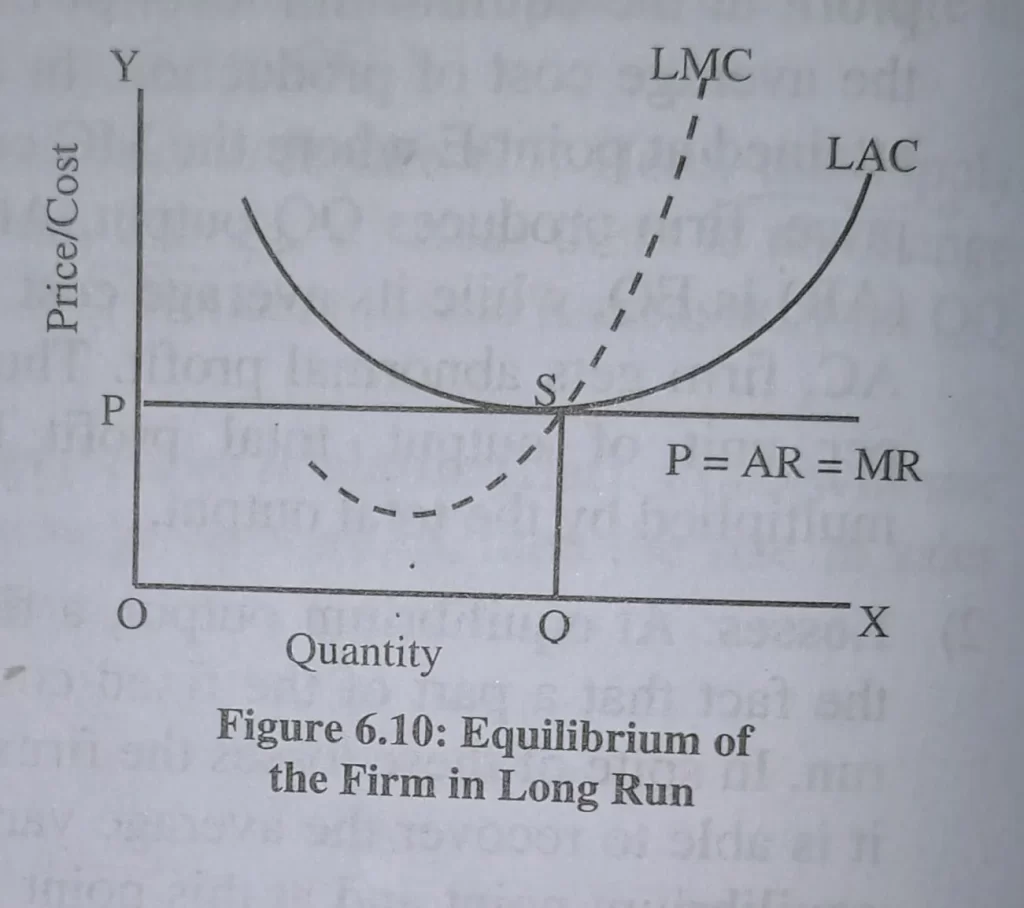
In figure 6.10, in this output stage, the price and output determination under perfect competition is as the average revenue and average cost are the same as QS, while OQ represents the equilibrium value. Because of this, the firm will only earn regular profits. In this case, as the average cost is low, the average and marginal costs will remain the same, so the long-term equilibrium conditions for a business will be: MR=LMC=LAC= Price.
Price and Output Determination Under Perfect Competition and Equilibrium of the Industry in Short-Run
When the total output is constant and shows no sign of expansion or decrease in output, the industry is considered to be in equilibrium for the short term. Thus, the business is in equilibrium when the entire industry is at equilibrium. It implies that the equilibrium is complete for the business in the short-term when all companies realize the average profit. The prerequisite for this is SMC=MR=AR=SAC. The market’s equilibrium is an unexpected and accidental event because, in the short term, some firms may earn more than average profits or experience losses.

Even then, the business is in short equilibrium, at the price at which it can clear the market, where the demand of quantity is greater than the quantity supply. In figure 6.11 the figure shows that in panel (1), the industry is at equilibrium at the point E that its demand curve and its supply curve S intersect. At the current price OP, some companies have been able to earn extraordinary profits PE1ST, as shown in Panel (2). Other firms are suffering FGE2P affections, as illustrated in Panel (3) of Figure 6.11.
Price and Output Determination Under Perfect Competition and Equilibrium of the Industry in the Long-Run
These are the primary conditions for price and output determination under perfect competition that establish the equilibrium of a higher market.
1.) In the long run, there is an long run marginal cost equal to the industry’s losses, producing an output level equal to the equilibrium that equals the marginal revenue from the long run (LMC= LMR). The total production of the industry consists of the output total of these companies
2.) There must be a set amount of firms within the field, and the entry of new firms is not allowable. In these cases, each firm should be earning average profits to the point at which either price or LAR=LAC is the same for all the companies. The business will not reach a steady equilibrium over the long term unless all companies make normal profits. If the same companies make an excessive profit, new participants will encourage to join, results in changes in supply and market prices over the long term. Therefore, for an industry to achieve equilibrium, it is helpful for all companies to earn regular profits over the long run.
3.) A long equilibrium value is resolute to achieve equality between all quantities of goods and services supplied over the long term in market liquidation. The equilibrium in the market’s long run is shown in figure 6.12.
Figure 6.12 The long-run price and output determination under perfect competition, OP determines the price by the intersection of the Supply curve, S, and Demand curve D. At this rate, the equilibrium for the firm is in calculation through the consumption of LMR = LMC. This means that OM is the output at the firm’s equilibrium over the long term. There is a complete equilibrium position. Price=LAR=LMR=LAC=LMC. In this way, the firm has normal earnings.
Long-run equilibrium, Price LAR=LAC=LMR=LMC.
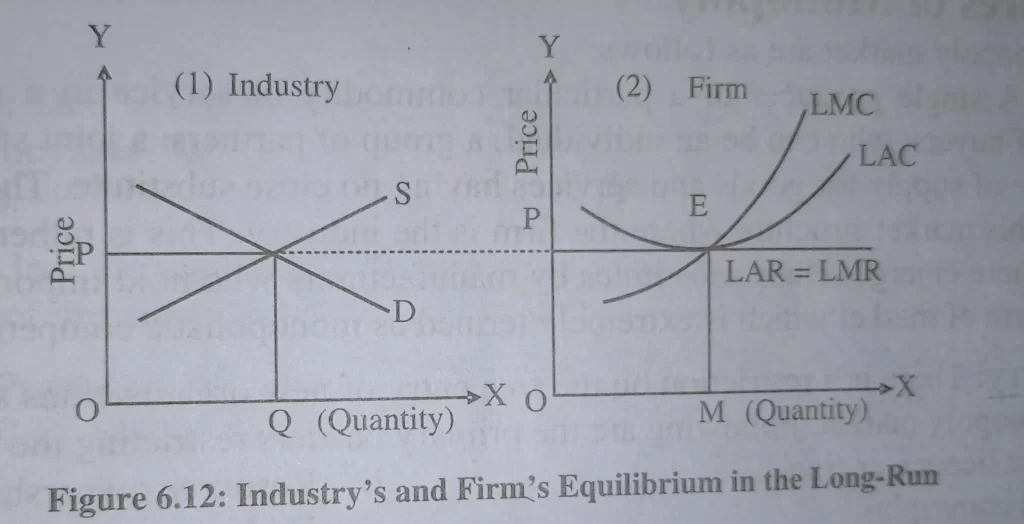
In other words, the number is stable when all firms are at equilibrium, making normal profits. The market supply position remains stable in the long term and with the specified demand D in (Figure 6.12 Panel 1). The long-run price and output determination under perfect competition and equilibrium value (OP) is set, placing the industries within the longer-run equilibrium. Firms operating under homogeneity conditions have identical cost functions and should be operating at the minimum level that LAC can reach (figure 6.12 Panel 2).
Some companies are quitting the business over time because they’re not efficient when it comes to higher-level cost functions, i.e., LAC price. Inability to make normal profits and unable to keep losses in check. In the end, firms’ and industries’ long-term equilibrium conditions are Long-Run Equilibrium Price=LAR=LAC=LMR=LMC. In the long run, price and output determination under perfect competition and the equilibrium conditions for firms include Long Run Equilibrium Price = LAR = LAC LMR = LMC.
How Price and Output is Determined Under Perfect Competition?
In perfect competition, price and output are determined by the interaction of demand and supply in the market. These forces decide the price of the industry. The firms will follow the prices decided by the forces of demand and supply.
Where Output is Determined in a Perfect Competition?
Output is the amount of goods produced by the producers. It is determined by the amount of goods and services that buyers are willing and able to purchase at a given price. It is decided at the point where MC curve intersects MR curve from below.
How is Price Determination done?
Price determination can be done in a number of ways, but the most common is through supply and demand. When there is more demand for a product than there is supply, the price of the product will go up. Conversely, when there is more supply than there is demand, the price of the product will go down.

